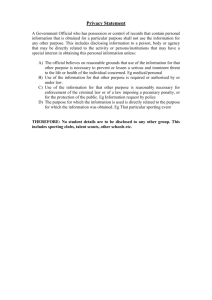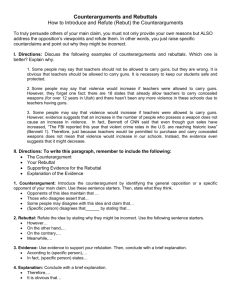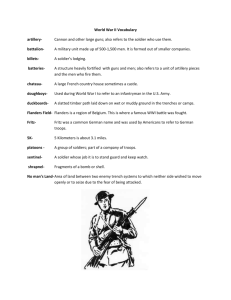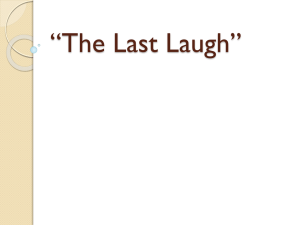Answers
advertisement
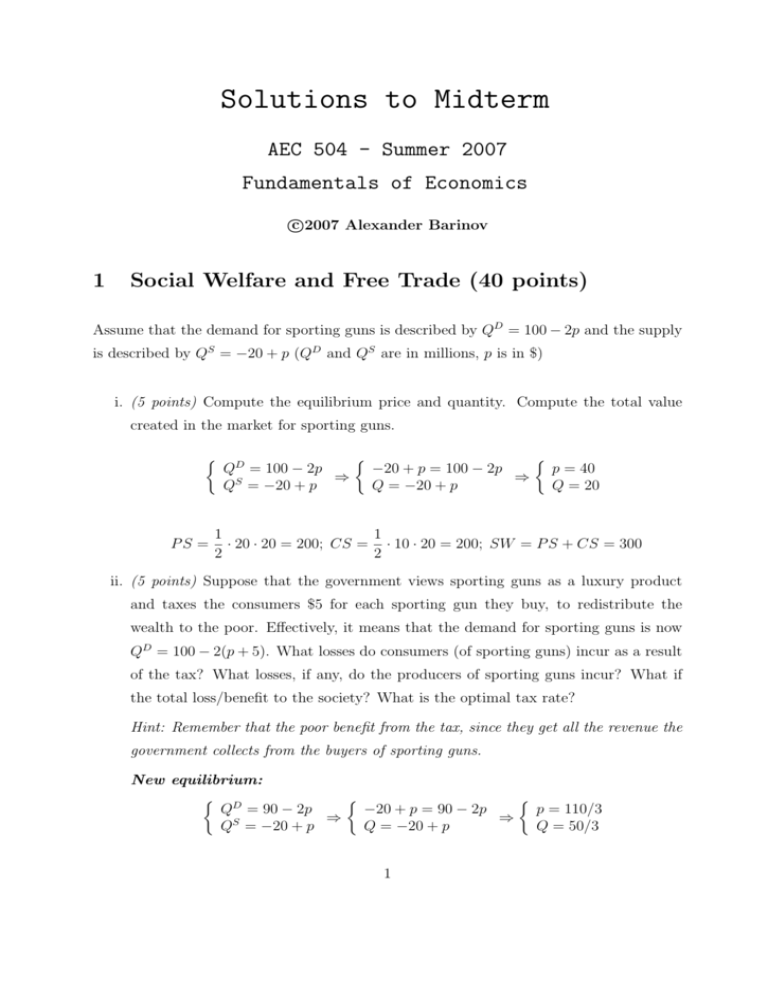
Solutions to Midterm
AEC 504 - Summer 2007
Fundamentals of Economics
c
2007
Alexander Barinov
1
Social Welfare and Free Trade (40 points)
Assume that the demand for sporting guns is described by QD = 100 − 2p and the supply
is described by QS = −20 + p (QD and QS are in millions, p is in $)
i. (5 points) Compute the equilibrium price and quantity. Compute the total value
created in the market for sporting guns.
PS =
QD = 100 − 2p
⇒
QS = −20 + p
−20 + p = 100 − 2p
⇒
Q = −20 + p
p = 40
Q = 20
1
1
· 20 · 20 = 200; CS = · 10 · 20 = 200; SW = P S + CS = 300
2
2
ii. (5 points) Suppose that the government views sporting guns as a luxury product
and taxes the consumers $5 for each sporting gun they buy, to redistribute the
wealth to the poor. Effectively, it means that the demand for sporting guns is now
QD = 100 − 2(p + 5). What losses do consumers (of sporting guns) incur as a result
of the tax? What losses, if any, do the producers of sporting guns incur? What if
the total loss/benefit to the society? What is the optimal tax rate?
Hint: Remember that the poor benefit from the tax, since they get all the revenue the
government collects from the buyers of sporting guns.
New equilibrium:
D
Q = 90 − 2p
−20 + p = 90 − 2p
p = 110/3
⇒
⇒
QS = −20 + p
Q = −20 + p
Q = 50/3
1
1 50 50
1250
1250
550
·
·
=
⇒ ∆P S =
− 200 = −
≈ −61.1
2 3 3
9
9
9
1 25 50
625
625
275
CS 0 = ·
·
=
⇒⇒ ∆CS =
− 100 = −
≈ −30.6
2 3 3
9
9
9
50
25
∆SW = ∆CS + ∆P S + 5 ·
= − ≈ −8.3
3
3
P S0 =
The optimal tax rate is zero (you will be able to show it formally in the
next section).
iii. (Hard, 15 points) Assume (for this part only) that the owners of sporting guns
destroy the wildlife and thus generate a negative effects on others. More precisely,
the ownership of Q millions of guns creates costs of 3Q3 /64 to the society. Find the
optimal tax rate in this case.
Equilibrium with taxes:
QD = 100 − 2t − 2p
⇒
QS = −20 + p
120 − 2t
p=
−20 + p = 100 − 2t − 2p
3
⇒
Q = −20 + p
Q = 60 − 2t
3
1
60 − 2t
60 − 2t
(30 − t)2
(30 − t)
(30 − t) · (30 + t)
SW = ·(30−t)·
+t·
=
+2t·
=
2
3
3
3
3
3
(30 − t) · (30 + t) 3 8
x · (60 − x) 1 1 3
T olal SW =
− · ·(30−t)3 = {30 − t ≡ x} =
− · ·x
3
64 27
3
8 9
x · (60 − x) 1 1 3
1
max
− · · x ⇒ 60 − 2x − · x2 = 0 ⇒ x = 15.32 ⇒ t = 14.68
X
3
8 9
8
We take the largest (positive) root, as the other one would yield the
minimum, not maximum to the total social welfare function.
So, the optimal tax rate is $14.68 per sporting gun, i.e. more than one
third of the equilibrium price without taxes. Protection of the environment seems to be a tough thing here.
From the formula for SW above (before taking into account the negative
effects the owners of sporting guns produce) one can see that t=0 really
maximizes the value created in the market for sporting guns.
2
iv. (5 points) Suppose now that the government is concerned about the dominance of
the low-cost foreign producers in the sporting guns market, so it sets the lowest price
at which a sporting gun can be sold – $35. What is the total loss/benefit to the
consumers, the producers, and the society as a whole?
Frankly speaking, $35 was a typo that made your life easier. Since the
limiting lowest price is lower than the equilibrium price, it is not really
limiting and has no influence on the market, as speed limit of 120 mph
would effectively mean “drive as fast as you like”. So, the answer is
that CS, PS, and SW do not change with the introduction of the lowest
price.
If the lowest price was $45 (which it was meant to be) the things will
change, because the consumers will only buy 10 (millions of guns) under
this price. The welfare changes are shown in the graph:
CS =
1
1
· 5 · 10 = 25 ⇒ ∆CS = −75; P S = · (25 + 15) · 10 = 200 ⇒
2
2
⇒ ∆P S = 0; ∆SW = −75
The fact that the limiting price did not bring any benefit or loss to the
producers is, of course, a mere coincidence. If the demand curve was
flatter, the quantity would respond more and the limiting price would
harm the producers as well as consumers. But it is true that the limiting
lowest price harms consumers more than producers.
v. (10 points) A famous shooter Bill Tell invents an enhanced version of a sporting
gun. Unlike Bill Gates, he is altruistic and commits to supplying the new guns at
the fixed price (equal to the cost of production) of $20. The demand function for the
new guns is the same as the demand function for the old ones. However, Bill Tell’s
invention drastically affect the market for the old guns, the demand for which now
becomes QD = 70 − 2p. What is the value of Bill Tell’s invention to the society as a
whole?
It is straightforward to find that Bill Tell will sell 60 (millions of new
guns) at $20, and the new equilibrium in the market for old guns will
3
be p = 30, Q = 10.
The benefit to the society from Bill Tell’s invention are equal to the value
created in the new market it establishes. Since Bill Tell is completely
altruistic, SW is equal to CS there. So, the benefit is
CSN ew =
1
· 30 · 60 = 900
2
However, inventions destroy old markets (the effect of “creative destruction” traced back to Joseph Schumpeter).
0
SWOld
=
1
0
· 15 · 10 = 75 ⇒ ∆SWOld
= −225
2
We also observe that the reduction of value created in the market for old
guns comes at the cost of both producer and consumer surplus. However, it does not mean that the invention harms some consumers, because they now can either buy an old gun at $30 instead of $40, or
switch to an older version at even lower price, whichever they find better, so they cannot be worse off. In fact, the graph shows that in the
market for old guns all consumers, who were willing to buy and bought
at high prices are gone (to the market for new guns, where they enjoy
higher surplus because of the low price), since the demand curve intercept in the market for old guns is even lower than the equilibrium price
there before the invention. So the small consumer surplus created there
goes now to those who bought no guns before (and enjoyed thus zero
surplus).
2
Apartment Glut (20 points)
In the aftermath of the dotcom crisis the market of rental apartments on the West Coast
suffered a large decrease in the demand
i. (5 points) The lendlords were considering offering either rent cuts or free services
of landlord’s employees (e.g., picking up and dropping off dry cleaning) as means of
4
attracting new clients. Which measure would be more efficient for lendlords of highquality apartments for the rich and which would be efficient in lending apartments
to the poor?
Hint: Think about opportunity costs.
Rent cuts save renter’s money, free services save renter’s time. Obviously, richer people (who make more money) have higher opportunity
cost of time, so they will appreciate time-saving discounts more than
poorer people. In fact, the optimal policy for landlords will be to offer
time-saving discounts to the clients who earn more than their employees (reallocating time-consuming tasks to those with lower cost of time
creates value).
ii. (5 points) Assume that the lendlords went with the rent cuts. Compared to the
situation before the price cuts (but after the decline in income associated with the
crisis), do you think the decrease in rent induced the consumers to spend more on
other goods (not apartments)?
The rent cut makes the consumers richer, because they have more money
to spend after they paid the rent. It makes them want more of other
goods (assuming other goods are on average normal goods). On the
other hand, after the price cut other goods become more expensive relative to apartments. It makes the consumers buy less of other goods and
rent better apartments. The overall effect on the amount of other goods
(and, because the prices of other goods do not change, on the spending
on other goods) is ambiguous.
iii. (5 points) An article about the aftermath of the dotcom crisis claimed: “In many
cities on the coasts, where new construction is more difficult and where an influx
of highly educated people over the last two decades has driven up home prices,
rents have held up better”. Discuss this statement in terms of supply and demand
interaction
The more difficult is construction, the higher are the costs of the developers. The higher are the costs of the developers, the lower is the supply
5
of apartments. High education means high wages, which in turn mean
higher income and higher demand for apartments (assuming the apartment is a normal good). So, on the coasts the supply of apartments was
growing more slowly, and the demand for them was increasing faster
than elsewhere, hence the rents declined less there.
iv. (5 points) Assume that the apartment is a necessity good and the own house is a
luxury good. Would you rather be a developer of houses or a developer of apartment
buildings during the recession after the dotcom boom?
Hint: Necessity goods have income elasticity less than 1, and luxury goods have
income elasticity greater than one.
The elasticities mean that the demand for apartments is less sensitive
to the changes in income than the demand for houses. In recession,
lower sensitivity to changes in income is good (the demand drops less).
Therefore, in the recession you would rather be a developer of apartment
buildings.
3
Consumer Choice (30 points)
Consider a consumer with utility function U = (x + 1)(y + 1) and income of 8. The prices
of x and y are 1.
i. (5 points) Compute the demand functions for x and y and the optimal allocation.
y+1
px
M U W = pW
=
px · x + px = p y · y + py
x+1
py
M UR
pR
⇒
⇒
⇒
px · x + px · +px − py = I
px · x + py · y = I
px · x + py · y = I
I + p y − px
x=
2px
⇒
I + px − py
y=
2py
To get the optimal allocation, just substitute the values of the prices
and the income into the demand functions:
x = (8 + 1 − 1)/2 · 1 = 4, y = (8 + 1 − 1)/2 · 1 = 4
6
ii. (5 points) Are the goods normal or inferior? Are they substitutes or complements?
The goods are normal, because their demands increase with income.
The demand for x increases as py increases, and vice versa, so they are
substitutes.
iii. (5 points) Compute the own-price, cross-price, and income elasticities of the demand
for x at the given prices and income.
ηpx (x) =
ηI (x) =
1
I · 2px
I
·
=
⇒ ηI (x) = 1
2px I + py − px
I + p y − px
ηpy (x) =
1
py · 2px
py
1
·
=
⇒ ηpy (x) =
2px I + py − px
I + py − px
8
−2px − 2I − 2py + 2px
−I − py
9
px · 2px
=
⇒ ηpx (x) = −
·
2
4px
I + py − px
I + py − px
8
iv. (5 points) What is the maximum amount the consumer will pay for the right to
consume x at the price of 1?
Hint: Think of what happens if he is precluded from consuming x and how to translate
this into an income decrease.
If the consumer cannot buy x, he will spend all his money on y, buy 8
units of it and achieve the utility of 9. If the consumer can buy x, he
can achieve this utility level with income of 4, so he will be ready to pay
up to 4 out of his current income of 8 to be allowed to buy x.
(
pW
M UW
y+1 =1
=
min x + y
x,y
M UR
pR
x+1
⇒
⇒
⇒
s.t.(x + 1)(y + 1) = 4
2
(x
+
1)
=
4
(x + 1)(y + 1) = 4
x=2
⇒
⇒I=4
y=2
v. (10 points) Suppose the price of x jumps to 4. What is the new optimal allocation?
What amount of money is needed to compensate the consumer for the price change?
What are the income and the substitution effects for x and y?
Again, just substitute the values in the demand functions from (i):
x=
8+1−4
5
8+4−1
11
= , y=
=
2·4
8
2·1
2
7
To find the necessary compensation, minimize the expenditure at the
new prices needed to reach the old utility level of (4 + 1) · (4 + 1) = 25:
(
M UW
pW
y+1 =4
=
min 4x + y
x,y
M UR
pR
x+1
⇒
⇒
⇒
s.t.(x + 1)(y + 1) = 25
2
4(x + 1) = 25
(x + 1)(y + 1) = 25
x= 3
3
2 ⇒ I = 4 · + 1 · 9 = 15 ⇒ ∆I = 15 − 8 = 7
2
y=9
The substitution effect is sliding up the indifference curve from the optimal bundle in (i) to the solution of the expenditure minimization problem:
SEx =
3
5
− 4 = − , SEy = 9 − 4 = 5
2
2
Because px went up and py stayed the same, SEx < 0, SEy > 0, exactly as
we find.
The income effect is jumping down from the solution of the expenditure
minimization problem to the optimal bundle in (v):
IEx =
5 3
7
11
7
− = − , IEy =
−9=−
8 2
8
2
2
Because px went up and py and I stayed the same, IEx < 0, IEy < 0,
exactly as we find.
8


